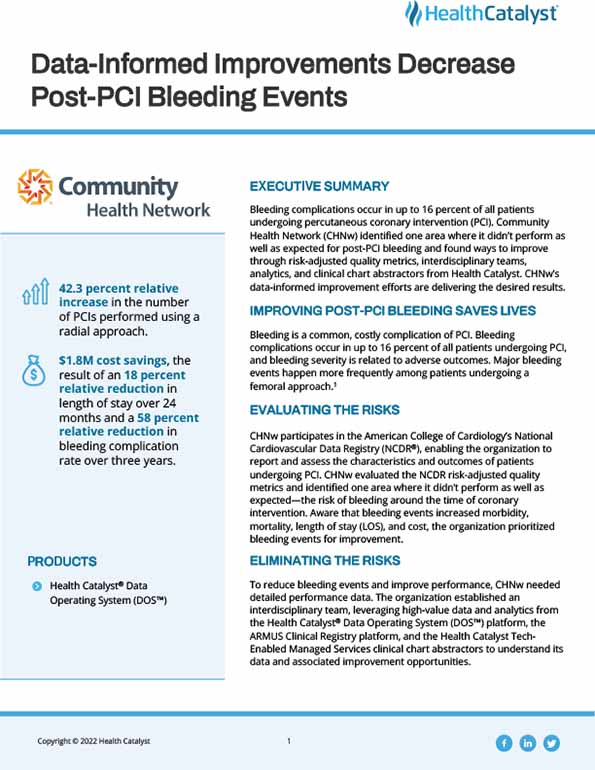Bleeding complications occur in up to 16 percent of all patients undergoing percutaneous coronary intervention (PCI). Community Health Network (CHNw) identified one area where it didn’t perform as well as expected for post-PCI bleeding and found ways to improve through risk-adjusted quality metrics, interdisciplinary teams, analytics, and clinical chart abstractors from Health Catalyst. CHNw’s data-informed improvement efforts are delivering the desired results.
Bleeding is a common, costly complication of PCI. Bleeding complications occur in up to 16 percent of all patients undergoing PCI, and bleeding severity is related to adverse outcomes. Major bleeding events happen more frequently among patients undergoing a femoral approach.1
CHNw participates in the American College of Cardiology’s National Cardiovascular Data Registry (NCDR®), enabling the organization to report and assess the characteristics and outcomes of patients undergoing PCI. CHNw evaluated the NCDR risk-adjusted quality metrics and identified one area where it didn’t perform as well as expected—the risk of bleeding around the time of coronary intervention. Aware that bleeding events increased morbidity, mortality, LOS, and cost, the organization prioritized bleeding events for improvement.
To reduce bleeding events and improve performance, CHNw needed detailed performance data. The organization established an interdisciplinary team, leveraging high-value data and analytics from the Health Catalyst® Data Operating System (DOS™) platform, the ARMUS Clinical Registry platform, and the Health Catalyst Tech-Enabled Managed Services (TEMS) clinical chart abstractors to understand its data and associated improvement opportunities.
The interdisciplinary team reviewed a year’s worth of bleeding event data, conducting deep dives into the data and identifying gaps. As a result of the detailed data review, CHNw:
CHNw evaluated benchmark data for the percentage of radial versus femoral approach PCI and set a goal to increase the overall rate of radial PCI. Physician leaders provided peer-to-peer education on the benefits of radial versus femoral approach, sharing the most recent literature, best practices, and outcomes data, engaging providers in changing to a radial-first approach.
TEMS clinical chart abstractors perform their work to abstract data and help monitor performance, notifying the medical director each time a patient does not receive the expected care. The medical director follows up with the physicians responsible for the patient, informing them of the expected standard and improvement opportunities.
"Improving quality performance is complicated, and there are no quick fixes. By getting deep into the data, the metrics, the care system, and effectively engaging key stakeholders, we successfully improved performance."
- Michael Robertson, MD, Interventional Cardiologist, Community Health Network
CHNw’s data-informed improvement efforts are delivering the desired results. The organization has achieved:
CHNw will continue using its TEMS clinical chart abstractors to abstract data for participation in various cardiovascular registries and monitor performance. The organization plans to continue using its NCDR data to continually improve care quality.




